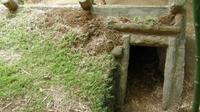Full-Day Demilitarized Zone Tour from Hue
tp. Huế, Vietnam
Trip Type: Day Trips
Duration: 9 hours
Vietnam's Demilitarized Zone was established by the Geneva agreement in 1954 as a dividing line between North and South in the outcome of the first Indochina War and ran roughly on the 17th parallel north latitude. During the American War it was the scene of heavy fighting. The area is, as so many parts of Vietnam are, blessed with the natural beauty and spectacular mountainous and jungle landscapes. Experience the remnants of war in this sadly tragic region still known by many as the DMZ (Demilitarized Zone). Names such as Khe Sanh, the Rockpile, Ben Hai River and Quang Tri still evoke deep emotions of the war to this day.
More About This Activity All Day Trips →
Vietnam's Demilitarized Zone was established by the Geneva agreement in 1954 as a dividing line between North and South in the outcome of the first Indochina War and ran roughly on the 17th parallel north latitude. During the American War it was the scene of heavy fighting. The area is, as so many parts of Vietnam are, blessed with the natural beauty and spectacular mountainous and jungle landscapes. Experience the remnants of war in this sadly tragic region still known by many as the DMZ (Demilitarized Zone). Names such as Khe Sanh, the Rockpile, Ben Hai River and Quang Tri still evoke deep emotions of the war to this day.You will leave Hue early in the morning and drive along the route 1A into Quang Tri province.
At the end of the defeat of the French in 1954 the Geneva conventions divided Vietnam into two areas along the 17th Parallel. Ho Chi Minh and his army controlled the North and President Diem, backed by the United States, controlled the South. Elections that were promised never eventuated and hence began a continued path of civil strife that led to American military involvement in South Vietnam. Throughout the war in the 1960's and 1970's the DMZ region became one of the heaviest bombarded regions in the history of warfare culminating in the 77 day siege at Khe Sanh and the complete destruction of Quang Tri by North Vietnamese forces in 1972.
Today, whilst there is little physical evidence of what was the region remains scarred from its damaging effects. Many of the hills remain scattered with rock and shrub from the intensity of artillery fire and chemical defoliants.
You will go back in time and visit some sites of those fierce battles still echoing in the present: the Hien Luong Bridge across the Ben Hai River, marking the 17th parallel, the 'physical' demarcation line between the two Vietnams. Situated along a scenic area of coastline, the fascinating tunnels at Vinh Moc, the tunnels were initially built in the late 1940's as a resistance hideout against the French and were extended and enlarged during the American war in order to accommodate civilian families trying to survive the constant terrifying aerial bombardment.
Under the guidance of a local and historically well-known guide, visit to the American Con Thien combat base and Carroll Camp artillery base will also be included, and the route 09 connecting Laos and the Dakrong suspension bridge that offers stunning views will end our day while driving through parts of Vietnam’s landmark during its devastating war.
Return to Hue in the late afternoon.
At the end of the defeat of the French in 1954 the Geneva conventions divided Vietnam into two areas along the 17th Parallel. Ho Chi Minh and his army controlled the North and President Diem, backed by the United States, controlled the South. Elections that were promised never eventuated and hence began a continued path of civil strife that led to American military involvement in South Vietnam. Throughout the war in the 1960's and 1970's the DMZ region became one of the heaviest bombarded regions in the history of warfare culminating in the 77 day siege at Khe Sanh and the complete destruction of Quang Tri by North Vietnamese forces in 1972.
Today, whilst there is little physical evidence of what was the region remains scarred from its damaging effects. Many of the hills remain scattered with rock and shrub from the intensity of artillery fire and chemical defoliants.
You will go back in time and visit some sites of those fierce battles still echoing in the present: the Hien Luong Bridge across the Ben Hai River, marking the 17th parallel, the 'physical' demarcation line between the two Vietnams. Situated along a scenic area of coastline, the fascinating tunnels at Vinh Moc, the tunnels were initially built in the late 1940's as a resistance hideout against the French and were extended and enlarged during the American war in order to accommodate civilian families trying to survive the constant terrifying aerial bombardment.
Under the guidance of a local and historically well-known guide, visit to the American Con Thien combat base and Carroll Camp artillery base will also be included, and the route 09 connecting Laos and the Dakrong suspension bridge that offers stunning views will end our day while driving through parts of Vietnam’s landmark during its devastating war.
Return to Hue in the late afternoon.
« Go Back

